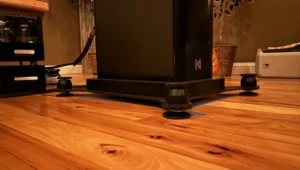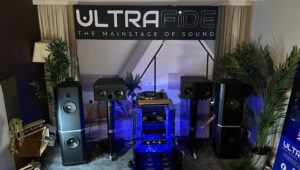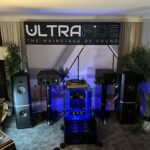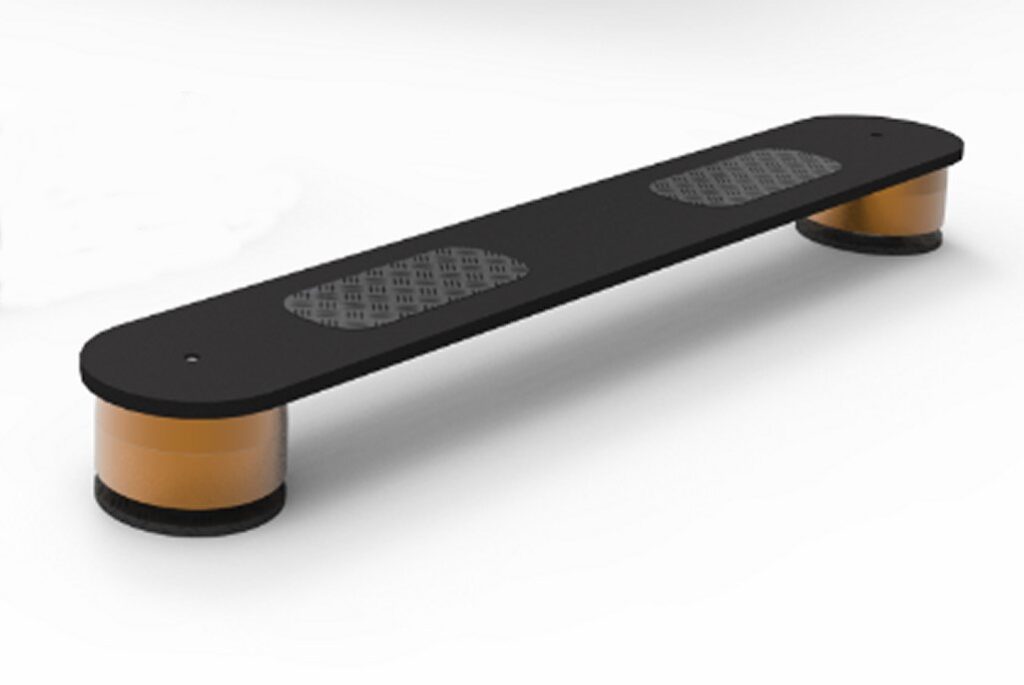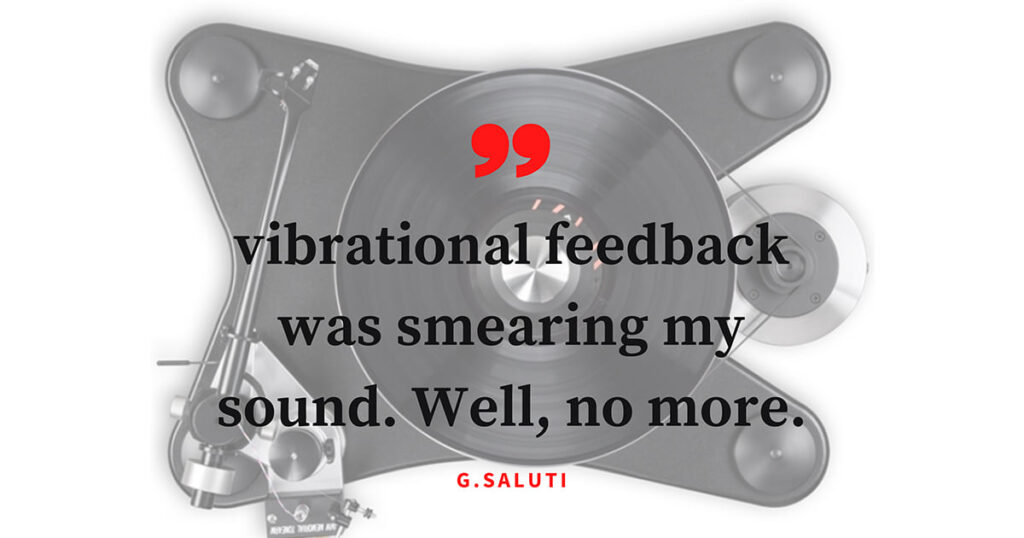by Jack Dinsdale
Conception
My initial ideas for what has become the Rock family of high performance record players were conceived in the late 1960s and early 1970s, not as a “big bang” (in any sense of the expression) but as the gradual coming together of a number of disparate ideas. The origins of these ideas were threefold. First, a general feeling that during the previous ten years record decks (turntables and arms) had not developed to the same extent as had pickups, amplifiers and loudspeakers. (Remember that during this period I had designed the world’s first successful transformerless semiconductor amplifier and described it in a series of well-received articles in the technical press, and I was also working on the design of a family of horn-loaded loudspeakers, again to be the subject of well-reviewed publications). Second, a critical examination of contemporary record decks from a strictly analytical viewpoint (Newton’s laws of motion, kinematics, lines of action/reaction of forces, etc) indicated that, well though these decks might sound, they broke many, if not all, of the rules by which I was then successfully designing precision machine tools and instruments at the Cranfield Unit for Precision Engineering (CUPE), a campus company set up on commercial lines at what is now Cranfield University. And third, a number of new ideas, techniques and materials were emerging from my work on precision machines that I felt could be applied to a radically new record deck.
It was about this time that Ivor Tiefenbrun, CEO of Linn Audio, announced that company’s first “Sondek” player with considerable hype and to great acclaim. This caused me little concern at the time, since as far as I could see, Linn’s designers were not aware of any of the basic “good mechanical engineering” points which by now were crystallising in my mind. (Anyone who has tried to “set up” a Sondek after installing a Rock will probably agree with me). Many folk have asked me whether Linn’s aggressive marketing of the Sondek has adversely influenced the Rock in any way. I reply that on the contrary, Linn prepared and conditioned the public, especially the technical press, to the idea that record decks possess a character of their own which can influence the sound of a record playing system as much as can amplifiers and loudspeakers. Linn’s pioneering work on the Sondek was carried out a full decade before the first Rock was marketed in 1983, and I’m sure now that without Linn’s unwitting help, the Rock with its innovative oil-damper wouldn’t have stood a chance.
Gestation
The first idea arising from my work at Cranfield which I felt could be used in a new high performance record player was a hydrodynamic non-contacting bearing. (Paradoxically, this bearing design has never been used in any of the commercial Rocks). The bearing was openly based on work by Muiderman of Philips who had developed an aerodynamic gas bearing to support ultra high speed rotors for gyro-compasses, using the pressure generated by patterns of micro-grooves etched into the bearing elements to provide sufficient support in both journal and thrust to prevent touch-down (catastrophic in the case of gyro rotors turning at over 105 rpm). A glance at Muiderman’s calculations showed that his gas bearing relied on the very high speed of the gyro rotor for its operation; there was no possibility of its operating at 331/3 or 45 rpm unless the reduction in speed could be matched by a corresponding increase in fluid viscosity. After further work, which included re-designing the bearing’s overall dimensions to make it more suitable for a record deck, a successful prototype was built, and patents were applied for by CUPE, nominating myself as inventor. CUPE management decided that the patent should be sold to a successful British manufacturer of record decks. At that time one British manufacturer was far and away the most successful: Garrard at Swindon. The company was duly approached, and after negotiation they bought the patent for a single down payment and a small royalty for each piece sold. There was no provision for a “minimum royalty” payment, an omission that CUPE and I were to regret as, almost immediately after the sale of the bearing patent, Garrard’s fortunes changed for the worse. In financial difficulty, Garrard was acquired by the British company Plessey (who had no background or, it seems, interest in sound reproduction) who then sold it to the Brazilian company Gradiente, famous for its low-cost low-quality decks but not known to be interested in low-volume up-market products. For the full 20 years (from 1972) of the patent’s life, Garrard/Plessey/Gradiente never marketed a single deck containing the fluid bearing, yet throughout this period the companies steadfastly refused either to grant CUPE a licence for its use, or even to sell it back to them. I often wonder whether, had Garrard marketed a high performance record deck using the fluid bearing (together with a few other innovative ideas that I, through CUPE, could have given them) at about the same time as the first Linn Sondek, they might have regained their hold on the top-end of the market, which they had previously held with their still-respected 301 and 401 decks, and a good British company would have remained British.
The second CUPE development that I privately earmarked for the “new record deck” was a material: synthetic granite. This material had been invented by Dr H J Renker, technical director of the Swiss precision machine tool company Fritz Studer AG, and further developed by CUPE who eventually acquired both British and American exploitation rights and set up a company to manufacture and market the material under the trade name Granitan S100. The material consists of carefully graded granite chips (95 per cent), ranging from several mm to under 1 mm across, the remaining 5 per cent being a special epoxy resin which binds the granite particles together in a “roman bridge” configuration. The material has reasonable strength, certainly sufficient for light-cut machine tools, although large and heavy-cut machines are probably best constructed of a thin (3 to 8 mm) steel skin containing synthetic granite; it has about the same specific stiffness (stiffness per density) as cast iron; and, most significantly, some ten times its internal damping properties. So as I still tell my students, “If you make a church bell of cast iron – and most church bells in the UK are made of cast iron – on Sunday morning they will ring out “Ding-dong”. But if you make the same bell of synthetic granite, it will ring out `Thik-thok'”. It occurred to me that with its reasonable strength and stiffness, and coupled with an exceptionally high damping factor, synthetic granite should be an ideal material for the base plinth and platter of a high performance record deck, and also for loudspeaker enclosures. This last surmise was also correct, and a pair of highly successful loudspeakers using synthetic granite as the enclosure material were designed and built in the early 1980s and are still in use.
It was now 1975, seven years since I had left industry to join CUPE. My articles on horn-loaded loudspeaker enclosures had been well received, and life was fast-moving but fun. Then I fell ill with acute viral meningitis which developed into encephalitis. When I surfaced from the coma in which I had lain for a week with a temperature nudging 41 degrees C, I found myself as weak as a kitten and unable to read and write. This faculty gradually returned, together with my strength, during the following month – my memory cells were intact but the communication paths linking them with my sight had to be rebuilt – but since then my mental recall has been five times slower than before, and until recently I suffered from permanent almost unbearable backache.
Returning to CUPE after an absence of twelve weeks, and with strict medical instructions to work only half-days for the next month (what a joke: I worked 8-hour days from my first week back at work, and thereafter), I was encouraged to move across from the industrial “campus company” work of CUPE to an academic appointment with Cranfield Institute of Technology (now Cranfield University) to set up a new graduate teaching department. The full story of DDMS (the Department for the Design of Machine Systems) has been recounted elsewhere. Its significance to the present subject is that all graduate students had to carry out a 6-month full-time project on which to write their Master’s thesis, and as course leader I now had access to a succession of student brains, hands and effort which could be applied to developing some of the many ideas waiting to be applied, in particular the new record deck.
Birth
The first opportunity to develop the new deck occurred the following year, 1977-78, when two graduate students, Michael Pezet and John Hardwick, worked under my supervision on separate aspects of the deck, the bearing and the arm. Pezet took the basic concept of the bearing, patented and sold to Garrard some five years earlier but as yet unexploited, refining the design and making and testing a number of prototypes. (The agreement with Garrard allowed Cranfield to develop and use the invention, provided this was not for commercial ends). Meanwhile, Hardwick tackled the problem of arm resonance, jointly supervised by my colleague Dr David Parkins and myself. Parkins was all for providing classical “dash-pot-and-piston” damping to the arm, but according to accepted thinking this could only be applied at the arm pivot where it hardly solved the problem. “Could you suspend a dash pot over the turntable, just in front of the pickup”, he asked me one day, “and move it along with the latter as it tracks the record?” “No”, I replied, “but you could cantilever an arc-shaped dash pot – like a trough – over the record and fix the piston just in front of the pickup!” The curved damping trough, characteristic of the Rock, had been invented. Hardwick developed the idea further for his Master’s project and a patent application was filed, with Hardwick, Parkins and myself as inventors.
The following year, 1978-79, another graduate student, Michael Clayforth-Carr, undertook for his Master’s project the challenge of integrating Pezet’s bearing with Hardwick’s arm damper into a complete record deck. All the work up till now had been on the basis of “a wing and a prayer” – no one had actually played a record using either the bearing or the arm damper. I was aware that ideally the deck structure (base plinth and platter) should be made of a highly stiff, very well damped material such as synthetic granite, but it would have been far too ambitious a project to introduce the material at this stage. Clayforth-Carr therefore used high-density chipboard reinforced with aluminium sheet (earthing the aluminium also provided some measure of shielding against electrical interference); he also designed a rudimentary arm and damper, and adapted a proprietary bearing and ac motor to drive the platter via a belt. The work took longer than expected, Clayforth-Carr suffered setbacks beyond his control, and so he applied successfully for an extension from the official submission date in September 1979 until the middle of October. And so it was that Max Townshend heard an impromptu demonstration of the first complete Rock, and the project gained a sponsor.
A few weeks earlier, during August 1979, I had spent a day in Harrogate at one of the Audio Fairs held periodically around the country, generally in hotels. To reach the show from my home entailed catching a train at about 7 am and changing three times before arriving at the show at about 11.30. At the Audio Fair I was, as always, lost in wonder and enthusiasm and I plunged into the throng as I began to explore the succession of stands, quite forgetting that I had not eaten for six hours. Suddenly, the hall began to rotate, my legs lost their feeling, and I realised that I was passing out. My next recollection was of sitting in a chair, being tended by a stranger with a strong Australian accent who was encouraging me to drink a can of Foster’s lager. The stranger was of course Max Townshend who, true to form, when he saw that I was well on the road to recovery asked if I would like to buy one of his Elite pickups. Sadly, I had to refuse – I was not in that particular market then – but Max quickly established that I was indeed the same Dinsdale who had designed the transformerless amplifier fifteen years before, thereby putting the lid on one of Max’s part-time jobs as a student, winding transformers for transistor audio amplifiers. We eventually parted with profuse thanks from myself and promises to keep in touch. True to my word, a few weeks later I invited Max to visit Cranfield to see some advanced precision engineering technology, and after a pleasant lunch we walked back through the student laboratory where Michael Clayforth-Carr was testing his prototype deck. It wasn’t all that much to look at. The student played part of a record without the damper, and the sound, fed through hastily assembled amplifier and loudspeakers was unremarkable. Then he repeated the test with the oil-filled damping trough in position, and Max’s jaw dropped to the ground. Hastening back, he asked for the experiment to be repeated, and we eventually moved on to my office to bid our farewells, Max deep in thought.
‘How much would it cost to sponsor this project?’ he asked.
I explained that I had already offered sponsorship options to three British companies, including Plessey (who by then had acquired Garrard) and that I was awaiting a response.
‘Would this be enough?’ Max asked, pushing a four-figure cheque, correctly made out to Cranfield, under my nose.
There have been a number of times in my life when the forces trying to twist my arm have been overpowering, and this was one of them. With Max sitting opposite me, I called each of the three companies to whom I had offered options on the new deck and told them that the project now had a sponsor. Shortly afterwards, Max returned home, little realising how much his life was about to be changed.
Childhood
As the 1979-80 session at Cranfield started I was worried that none of the students wished to carry on with Clayforth-Carr’s work. But then the project had a stroke of luck: two students joined the course a week late, and one of them, John Bugge, decided to carry on with the record deck for his individual project. Bugge was an amazing student; older than the others, he had just obtained a first class honours degree from the Open University, and he was an obsessive worker. Although he had no background in high quality audio, nor any previous interest in the subject, he set to with a will to tackle the design and manufacture of a plinth and platter assembly in synthetic granite, a damping trough in the same material, a hydrodynamic fluid bearing, and also the two areas which had not been worked on yet: the drive for the platter and the detailed design of the arm.
During my seven years with CUPE before my illness I had worked extensively with direct drive permanent magnet dc torquemotors as supplied by, among others, the Inland Motor division of Kollmorgen Corporation based in Radford, Virginia, USA. I had visited the company in Virginia and contributed to their technical sales seminars, and I knew their UK distributors very well. Initially I realised that in spite of its exceptional performance in machine tool drives, this motor would not be suitable for driving a record player because of the mechanical and electrical noise generated by the brushgear. However, this situation had changed dramatically in the mid-1970s when a brushless version of the motor appeared. (Strictly speaking it was no longer a dc motor; how can a motor driven by two or three sinusoidal signals be classified as “dc”?) The motor was now ideally suited to driving the new record deck, and I was able to pull on my friendship with the UK distributors to obtain a sample. (Even then, British university departments had very small development budgets. The situation is even worse now). It was essential that the speed of rotation should be precisely controlled. The frequency of the public electricity supply couldn’t be relied on – a digital clock was clearly necessary, although ideally this should be capable of being “pulled” a few per cent up or down, to satisfy those tiresome listeners (myself among them) who have perfect musical pitch and object to listening to records which for whatever reason sound slightly sharp or (more usually) flat. Having resolved to use a digital source for the master frequency it seemed logical to use digital techniques for measuring the actual rotational speed. Again the work of CUPE came to the rescue in the shape of Moire Fringe grating technology, with which I had become familiar some years before. It was an easy matter to fix a suitable grating on the underside of the platter, and John Bugge developed the fringe sensors and a third order digital servo control system to power the direct drive brushless motor mounted on the non contacting fluid bearing supporting the synthetic granite platter.
I had been interested in the optimum design of pickup arms (formerly known as `tone arms’) ever since meeting Percy Wilson in the early 1960s. Wilson was then technical editor of the respected British monthly journal `Gramophone’ which had been founded by the author, musician and raconteur Sir Compton Mackenzie, who I also had the privilege of meeting before he died. (Sorry, Editor, I know that name-dropping is bad manners – that’s just what the Queen said to me at Buckingham Palace the other day). Wilson was the first to propose (in 1923, I think) the use of “offset” and “overhang” to reduce lateral tracking distortion to respectable levels. Careful examination of a large number of commercial arms showed that very few designers had any idea either of kinematics or of the action and reaction of forces. Briefly, the arm should be designed according to modern theory of offset and overhang (most designers were getting that part correct) but in addition, if the design can be so contrived that all of the external forces act through a single point which is also the centre of gravity and through which pass the centre lines of the bearings, an audible `magic’ situation is achieved which improves the sound immensely. I explained all of this to John Bugge, who designed and built the first “Excalibur” arm, the design of which has scarcely changed in fifteen years.
Adolescence
Following the completion of his Master’s project and thesis in 1980 a company was set up by Bugge, with Cranfield’s approval, to manufacture the first commercial Rock player for Max Townshend’s company Elite Gramophones to market. Meanwhile, Bugge’s superb-sounding prototype was being used by Max and myself at conferences and at Audio Fairs to drum up interest and enthusiasm for the new deck, and to accustom both the public and the technical press to the novel idea of front-end damping. Unfortunately it took 18 months longer than scheduled to bring the first Rock to the market; some corners were cut which should not have been; and although the deck was awarded a prize for Design and Engineering at the prestigious Chicago Audio Convention in April 1983, sales failed to meet the minimum number for economic survival and the company was wound up later that year.
Adulthood leads to Maturity
The basic Rock concept was subsequently developed by Max Townshend’s company through a series of commercial versions: the Elite Rock (1985), the economy Avalon (1987), the outstanding Rock Reference (1989) and the equally outstanding Mk III Rock (1992). The properties and rationale behind the Mk III Rock have been described elsewhere.
Future Developments
While Max was enjoying modest success with the various Rock incarnations, I was still working at Cranfield (where I had been appointed to a Professor’s chair in 1984). I had by now become obsessed with the problem of eliminating lateral tracking distortion while retaining the concept of a pivoted arm. (Linear tracking arms may have some advantages in this respect, but these are far outweighed by the disadvantages associated with the drives and the adverse dynamics). A careful search of the patent libraries showed the elimination of lateral tracking distortion to be one of the most fertile areas for ingenious ideas (and some less so). It also warned me that to invent a truly novel solution would be most difficult. Chasing sketches and formulae around a sheet of paper one day I hit on the idea of mounting the arm pivot eccentrically on a motorised base which would slowly rotate as the pickup tracked the record, the base motion being controlled to the necessary non-linear profile by means of an optical sensor following a suitably shaped cam. More work needed to be done before deciding whether the idea was feasible, let alone patentable, and again a graduate student on the Master’s course came to my aid. Robert Berks pursued this idea for his individual project in 1984 and established the boundaries for successful operation, and on conclusion of his work we applied (again through Cranfield) for a patent. Obtaining the British and European patents was relatively easy; persuading the US examiner, the infamous Stephen Stefan, that my idea was novel took almost a year of detailed technical argument, but the US patent was eventually granted in 1987. It was not however until 1994, when I was working at the University of Dundee, that this patent was developed to full feasibility and a working prototype by Michael Tindell, a graduate student working on the Master’s course in Mechatronics run jointly by the University of Dundee and the University of Abertay Dundee.
Following the granting in 1987 of my patent for an eccentrically-mounted arm pivot on a motorised base, Max Townshend had put in a lot of work computing the correct cam profile for the servo to follow, and it was timely that Tindell should now choose the subject for his individual project. Tindell developed the servo control circuits including the optical tracking system for following the cam profile. Subsequent tests, both subjective (listening) and objective (electrical measurements) have confirmed the correct operation of this innovative design which has virtually eliminated lateral tracking distortion. At the same time, Max took the opportunity to incorporate an idea of his own: motorised raising/lowering of the arm pivot (totally independent of the lateral tracking correction) to alter the vertical tracking angle and hence, by careful adjustment by ear – we know of no way in which this adjustment can be made automatically – to eliminate vertical tracking distortion. Early listening tests suggest that this development will also be successful, but further work on the ergonomics and user-friendliness of the system are clearly needed.
The most recent development has tackled one of the few remaining areas of audible distortion in vinyl LP reproduction, cyclic variations in pitch caused by eccentricity between the recorded grooves and the “hole in the middle” (which frequently isn’t). Tindell’s original remit was to examine this problem as well as that of lateral tracking distortion, and he conceived (and reported in his Master’s dissertation) a number of possible schemes, the most promising of which was to detect eccentricity by sensing the cyclic in-out motion of the arm using a Moire fringe measuring system and converting this into two orthogonal components aligned with the platter. The platter would be constructed as a 3-member horizontal sandwich. The lowest member would be mounted on a suitable bearing and driven conventionally via a belt-drive to a sub-platter. On this lowest member would slide the second member, driven by a stepper motor mounted in the lowest member and constrained to move linearly in response to pulses supplied to the stepper motor. Mounted on the second member, the third (top) member would move linearly at right angles to the movement of the second member, in response to pulses supplied to a second stepper motor, also mounted in the lowest member. The power supply to both stepper motors and the associated electronics would be supplied by batteries mounted in the lowest member, since any attempt to use brushes or slip-rings would generate unacceptable mechanical noise. Similarly, any attempt to transmit information to the stepper circuits from the Moire fringe sensors other than by radiation would be unacceptable, and an infra-red link was chosen to ensure that there would be no interference with the audio signal from the pickup. It is important that the battery drive should last for several years under normal usage, and so the use of a “wake-up” circuit was proposed to alert the platter drive circuits that they were about to be used.
Tindell was unable, because of time constraints, to progress beyond the initial conception of this arrangement, and so a further graduate student, Emmanuel Mantouvalos, undertook this part of the work as his individual project in 1995. He made good progress with the actuation, but once again it took Max Townshend’s genius and sheer hard work to design and build a working model of the Moire fringe sensing arrangement and the associated circuitry. Max completed this part of the project in 1997 and once again the design assumptions proved correct: the new arm arrangement with zero tracking error – both vertically and horizontally – sounds superb, and has received much acclaim whenever demonstrated at audio shows. As recounted elsewhere, I decided to take early retirement from the university system in 1999, and it will therefore be up to Max Townshend (once again) to complete the work on turntable eccentricity elimination.
Reflections
The design of high performance audio equipment, whether mechanical, electronic or (in combination) mechatronic, has provided me with some most difficult technical challenges, especially when the commercial considerations of manufacturing for a financially-aware marketplace are taken into account. At the same time, the rewards have also been immense: the domestic reproduction of music to a startling, often emotive, degree of accuracy. Even the highest standard of professional sound reproducing equipment cannot fully achieve the precise ambience of a live performance – it probably never will (quite) – so why don’t I simply attend more recitals and concerts? There are of course concerns with cost and geography which affect most of us, but for me there has always been a far more important reason. Performers cannot live for ever, but their artistry can live on through their recordings. During my life I have been privileged to meet many great musicians, some of whom have become good friends. For me it has been a happy duty to play a small part in designing the means of enabling their performances to live on, as faithfully to the original as science and engineering will permit, long after the musicians themselves have passed away. I hope that I will be able to continue to do this, well into retirement.

